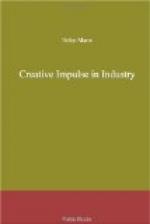For the educational purposes of the experiment the selection of the industry would not be made on the ground that the technical processes of one required greater intellectual activity than another; neither would the selection depend upon whether or not the industry chosen offered young people better chances than another for entrance to a trade where jobs, comparatively speaking, drew fair rates of wages, or the economic conditions were in other respects superior. The experiment would in no sense be a trade preparation but an experience where the enterprise of production was opened up and the possibilities of creative life were realized in association with others, so far as the conditions and time allowed.
The industrial basis for selection of such experiment should hinge, first, on whether or not the young people could function in the industry advantageously to themselves educationally speaking and to the industry socially considered: that is, whether or not the productive processes were in line with the capacity of adolescent children and the product was of social value; second, whether the product could be introduced successfully in the market and the enterprise become self-supporting.
At the present time, a proposition for the promotion of such an educational experiment is being worked out. Wooden toys have been chosen as the article for manufacture, because, first, the models were sufficiently simple in construction to make the work practical for young people who make up the workshop staff; it is practical for the majority of the staff to range in age from 14 to 17 years. Second, the work done by Caroline Pratt on children’s playthings has disclosed the fact that the present toy market is below grade from the point of view of the service of toys to children. The market does not supply the children with the sort of material and the sort of tools they require in their play schemes. Therefore, the product chosen has a legitimate social claim on the market. However, it would be valid, though not so interesting, if a certain sort of paper box which filled a legitimate trade need had been selected and a paper box factory had been set up as the basis of the experiment. As a theoretical illustration of my general thesis, paper boxes would serve better than wooden toys, because the latter product, as it is conceived, covers special intellectual content. But the particular sort of content is not a fundamental requirement for the educational purpose of the experiment. However, as the experiment is actually being planned in connection with wooden toys, I shall use the plan, as far as it is worked out, as my illustration. I shall refer later in discussing the school curriculum to the special intellectual content which the manufacture of these toys will represent.




